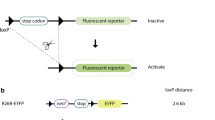Abstract
Embryonic development entails a well defined temporal and spatial programme of gene expression, which may be influenced by active chromosomal domains. These chromosomal domains can be detected using transgenes which integrate randomly throughout the genome, as their expression can be affected by chromosomal position1–3. Position effects are probably exerted most strongly on transgenes that do not contain strong promoters, enhancers or other modulating sequences. Here we have systematically explored position effects using a transgene with the weak herpes-simplex-virus thymidine-kinase promoter, linked to the readily visualized lacZ indicator gene (HSV-TK-lacZ). Each transgenic fetus with detectable expression displayed a unique lacZ staining pattern. Thus expression of this construct is apparently dictated entirely by its chromosomal position, without any construct specificity. Furthermore the transgene is faithfully transmitted to subsequent generations, allowing for systematic mapping of changes in expression during development and in adult life. These results demonstrate that transgenes can indeed be powerful tools to probe the genome for active chromosomal regions, with the potential for identifying endogenous genes involved in organogenesis and pattern formation.
Similar content being viewed by others
References
Palmiter, R. D. & Brinster, R. L. A. Rev. Genet. 20, 465–499 (1986).
Jaenisch, R. et al. Cell 24, 510–529 (1981).
Lacy, E., Roberts, S., Evans, E. P., Burtenshaw, M. D. & Costantini, F. D. Cell 34, 343–358 (1983).
Wagner, M. J., Sharp, J. A. & Summers, W. C. Proc. natn. Acad. Sci. U.S.A. 78, 1441–1445 (1981).
Hall, C., Jacob, P., Ringold, G. & Frank, L. J. molec. appl. Genet. 2, 101–109 (1983).
Wagner, E. F., Stewart, T. A. & Mintz, B. Proc. natn. Acad. Sci. U.S.A. 78, 5016–5020 (1981).
Brinster, R. L., Chen, H. Y., Warren, R., Sarthy, A. & Palmiter, R. D. Nature 296, 39–42 (1982).
Butner, K. & Lo, C. W. Molec. Cell Biol. 6, 4440–4449 (1986).
Sanes, J. R., Rubenstein, J. L. R. & Nicolas, J-F. EMBO J. 5, 3133–3142 (1986).
Turner, D. L. & Cepko, C. L. Nature 328, 131–136 (1987).
Goring, D. R., Rossant, J., Clapoff, S., Breitman, M. L. & Tsui, L. C. Science 235, 456–457 (1987).
Allen, N. D., Barton, S. C., Surani, M. A. H. & Reik, W. in Mammalian Development—A Practical Approach (ed. Monk, M.) 217–233 (IRL Press, Oxford, 1987).
Stewart, C. L., Schuetze, S., Vanek, M. & Wagner, E. F. EMBO J. 6, 383–388 (1987).
Rohdewohld, H., Weiher, H., Reik, W., Jaenisch, R. & Breindl, M. J. Virol. 61, 336–343 (1987).
Swanson, L. W. et al. Nature 317, 363–366 (1985).
Low, M. J. et al. Science 231, 1002–1024 (1987).
Das, O. P. & Massing, J. W. Molec. Cell. Biol. 7, 4490–4497 (1987).
Soriano, P., Cone, R., Mulligan, R. & Jaenisch, R. Science 234, 1409–1413 (1986).
Shani, M. Molec. Cell Biol. 6, 2624–2631 (1986).
Jahner, D. & Jaenisch, R. Molec. Cell Biol. 5, 2212–2220 (1985).
Sorge, J., Cutting, A., Erdman, V. & Gautsch, J. Proc. natn. Acad. Sci. U.S.A. 81, 6627–6631 (1984).
Barklis, E., Mulligan, R. & Jaenisch, R. Cell 47, 391–399 (1986).
Taketo, M. & Tanaka, M. Proc. natn. Acad. Sci. U.S.A. 84, 3748–3752 (1987).
Hamada, H. Molec. Cell Biol. 6, 4179–4184 (1986).
Hamada, H. Molec. Cell Biol. 6, 4185–4194 (1986).
Forrester, W. C., Takegawa, S., Papayannopoulou, T., Stamatoyannopoulos, G. & Groudine, M. Nucleic Acid Res. 15, 10159–10177 (1987).
Grosveld, F., van Assendelft, G. B., Greaves, D. R. & Kollias, G. Cell 51, 975–985 (1987).
Wilkie, T. M., Brinster, R. L. & Palmiter, R. D. Devl Biol. 118, 9–18 (1986).
O'Kane, C. J. & Gehring, W. J. Proc. natn. Acad. Sci. U.S.A. 84, 9123–9127 (1987).
Author information
Authors and Affiliations
Rights and permissions
About this article
Cite this article
Alien, N., Cran, D., Barton, S. et al. Transgenes as probes for active chromosomal domains in mouse development. Nature 333, 852–855 (1988). https://doi.org/10.1038/333852a0
Received:
Accepted:
Issue Date:
DOI: https://doi.org/10.1038/333852a0
- Springer Nature Limited
This article is cited by
-
Tmem161a regulates bone formation and bone strength through the P38 MAPK pathway
Scientific Reports (2023)
-
Digestion and utilization of plant-based diets by transgenic pigs secreting β-glucanase, xylanase, and phytase in their salivary glands
Transgenic Research (2023)
-
Development of an efficient screening system to identify novel bone metabolism-related genes using the exchangeable gene trap mutagenesis mouse models
Scientific Reports (2017)
-
Improvement of anti-nutritional effect resulting from β-glucanase specific expression in the parotid gland of transgenic pigs
Transgenic Research (2017)
-
The aflatoxin-detoxifizyme specific expression in mouse parotid gland
Transgenic Research (2015)





